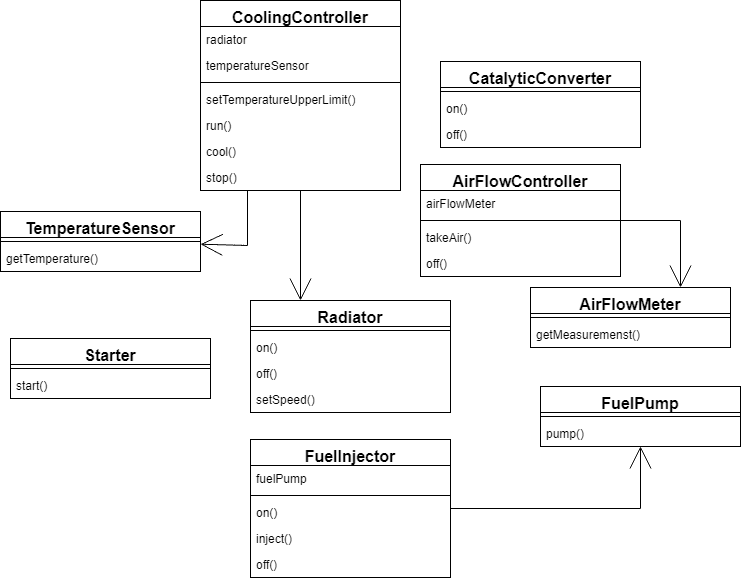1. 引言
本文将深入探讨结构型设计模式中的外观模式(Facade Pattern)。我们将:
- 概述该模式的核心思想
- 列举其主要优势
- 分析它解决的实际问题
随后通过 Java 实例演示外观模式在现有系统中的具体应用。
2. 什么是外观模式?
简单来说,外观模式通过一个简洁的接口封装复杂的子系统,实现两大核心目标:
- 隐藏复杂性:将子系统内部的复杂交互逻辑封装起来
- 简化使用:为客户端提供简单易用的操作入口
⚠️ 需要注意:
- 外观模式不会限制直接访问子系统
- 客户端仍可绕过外观直接使用底层组件
核心优势
✅ 解耦客户端与子系统:修改子系统实现时不会影响客户端代码
✅ 降低使用门槛:将多步操作封装为单一方法调用
✅ 保持灵活性:不强制客户端必须使用外观接口
3. 实战示例
假设我们要实现汽车启动系统。下图展示了传统实现方式:

传统实现的问题
启动引擎需要13行代码且必须严格按顺序执行:
airFlowController.takeAir()
fuelInjector.on()
fuelInjector.inject()
starter.start()
coolingController.setTemperatureUpperLimit(DEFAULT_COOLING_TEMP)
coolingController.run()
catalyticConverter.on()
关闭引擎同样繁琐:
fuelInjector.off()
catalyticConverter.off()
coolingController.cool(MAX_ALLOWED_TEMP)
coolingController.stop()
airFlowController.off()
外观模式改造
创建 CarEngineFacade 类封装所有复杂操作:
public class CarEngineFacade {
private static int DEFAULT_COOLING_TEMP = 90;
private static int MAX_ALLOWED_TEMP = 50;
private FuelInjector fuelInjector = new FuelInjector();
private AirFlowController airFlowController = new AirFlowController();
private Starter starter = new Starter();
private CoolingController coolingController = new CoolingController();
private CatalyticConverter catalyticConverter = new CatalyticConverter();
public void startEngine() {
fuelInjector.on();
airFlowController.takeAir();
fuelInjector.on();
fuelInjector.inject();
starter.start();
coolingController.setTemperatureUpperLimit(DEFAULT_COOLING_TEMP);
coolingController.run();
catalyticConverter.on();
}
public void stopEngine() {
fuelInjector.off();
catalyticConverter.off();
coolingController.cool(MAX_ALLOWED_TEMP);
coolingController.stop();
airFlowController.off();
}
}
改造效果
客户端代码从13行简化为2行:
facade.startEngine();
// ...
facade.stopEngine();
4. 潜在缺陷
外观模式虽然强大,但需注意:
- ❌ 过度封装:在简单场景中可能增加不必要的抽象层
- ❌ 维护成本:当子系统接口频繁变更时,外观类需要同步更新
- ⚠️ 性能考量:多层封装可能带来微小的性能开销(通常可忽略)
5. 总结
外观模式通过封装复杂子系统,为客户端提供简洁统一的操作接口。其核心价值在于:
- 显著降低系统使用复杂度
- 有效隔离客户端与子系统实现
- 保持底层系统的可访问性
完整实现代码已托管至 GitHub,欢迎参考实践。